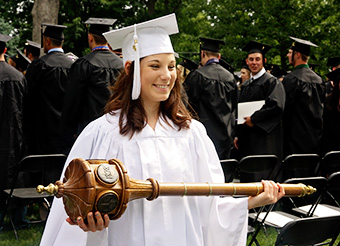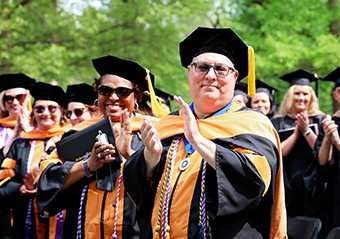Inauguration
We are One McKendree!
In February 2021, the McKendree community celebrated the inauguration of Daniel C. Dobbins '81 as the 33rd president of McKendree University!
Watch the Presidential Installation
Click to watch the installation or view it below.
Inauguration Program
Download the Inauguration Program or view it below.
Letters of Congratulations
Download the Letters of Congratulations or view it below.
In the spirit of welcoming President Dobbins to McKendree, please consider a gift that can help change lives by providing access to a high quality education. Learn more and give online.
Watch the Celebration Chapel Service
Click to watch chapel service or view it below. Browse the program booklet.
Biography
On Jan. 1, 2020, Daniel C. Dobbins ’81 became McKendree University’s 33rd president, succeeding Dr. Jim Dennis, who retired after 26 years.
President Dobbins’ McKendree story is one of loyalty, leadership and love, a journey
from the classroom to the boardroom. The 6' 8" student from the west-central farming
community of Pittsfield, Ill., studied business administration, played forward and
center for the Bearcats, and met his college sweetheart, the petite and outgoing Michaelene
“Mickey” Macaluso, on the Lebanon campus. The couple earned their bachelor’s degrees
in 1981 and married that year. Mickey worked in McKendree’s Office of Admission, while
Dan became an accountant and pursued his CPA and MBA, graduating from Southern Illinois
University Edwardsville in 1985.
Inspired by gratitude, the Dobbinses became stewards of McKendree as volunteers and
donors immediately after graduation. In 1987, Dan was elected president of the Alumni
Association Board and, by virtue of that position, a member of the Board of Trustees.
In 1999, the Alumni Association rewarded him with its most prestigious honor—the Peter
Akers Award. In 32 years as a trustee, he chaired the Resource Development and Financial
Affairs Committees, and served as treasurer (1998-2005), vice chair (2005-2007), and
board chair (2007-2015). The University conferred on him an honorary Doctor of Humane
Letters degree at the 2015 Commencement ceremony to recognize his years of service
and leadership as board chair. He has truly given his time, talent and treasure to
McKendree.
President Dobbins’ business acumen and experience, supported by years of service and
commitment to his alma mater, guide him in his new role. He is the former president
of Fiber Bond Corporation, an air filtration products manufacturing company in Michigan
City, Ind.
He views the opportunity to lead McKendree forward as a continued call to service.
“I am deeply committed to the mission of this great University and it has been a privilege
for me to work on behalf of its students and all of the members of the McKendree community
as a volunteer,” he said. “As I begin this new chapter in my relationship with the
University, I am deeply humbled and excited by the opportunity to continue that service
as president and I am grateful for the strong and enduring leadership of Jim Dennis,
who has left a lasting legacy on which we have the opportunity to build.”
Academic Ceremony
 McKendree University Mace
McKendree University Mace
The tradition of the academic mace dates from the late 14th century when two ancient
instruments, the royal scepter and the battle mace, were combined to form a symbol
of the authority of the leader of a university. Noblemen carried the battle mace as
weapon and as a staff of command.
Today the academic mace indicates that the president of a university or college is
the embodiment of the power, authority, autonomy, and sovereignty of the institution.
The McKendree mace was fashioned from a white oak tree planted near Wildy Hall at
a time near the founding of the college in 1828. The tree was felled in 2004 by a
summer storm, and the McKendree Board of Trustees, in recognition of the tenth anniversary
of the presidency of Dr. James M. Dennis, commissioned the creation of the McKendree
mace.
The images represented on the mace are 1828, the year of McKendree's founding, a likeness
of Bishop William McKendree, the Lamp of Knowledge, Bothwell Chapel, the symbol of
the United Methodist Church, and the seal of the University.

Academic Dress
The attire of the platform party for this inauguration is rooted in medieval times,
and has evolved from the medieval universities of Paris, Bologna, Oxford, and Cambridge.
The precise beginnings of the several parts of the academic regalia are difficult
to determine. Because medieval students enjoyed the status of clerics during their
university years, it is believed that their attire found its inspiration in the clerical
dress of the times. The gown is an adaptation of the robe of the friar or priest;
the hood, of the friar’s cowl; and the mortarboard cap, of the skull cap, which protected
tonsured heads against the drafts of medieval classrooms.
In the 1890s when McKendree College was in her seventh decade, academic attire first
began to appear in the United States. Its use now is common for college and university
functions, and its pattern is uniform.
The Gown
The flowing gown comes from the 12th century. While it originally may have been worn as protection form the chill of
unheated buildings, today it symbolizes the democracy of scholarship, covering any
trappings of rank or social standing underneath.
Three types of gowns are worn for McKendree University Commencement exercises: the
bachelor’s, the master’s, and the doctor’s. The bachelor’s gown is a yoked, closed-front
garment with long, pointed sleeves. The master’s gown has long, closed sleeves slit
just above the elbow, permitting the forearms to protrude. The doctor’s gown has full,
bell-shaped sleeves and is trimmed with velvet panels down the front and three velvet
bars on each sleeve. Black trim is acceptable for all gowns of the doctorate. The
color of the panels and sleeves varies to indicate the doctoral degree held. The color
of the gown designates colors of the college or university where the degree was earned.

The Hood
The hood was originally worn over the head and attached to the gown. When the skull
cap was introduced, the hood was retained but detached. Today it is worn around the
front of the neck, draped over the shoulders and hung down the back of the gown. Each
graduate degree (master’s and doctorate) has its special hood, which varies in length
and, with the doctorate, in pattern.
Colors lining the hood are those of the institution granting the degree. McKendree
displays white chevrons on a purple background. The colored velvet binding on the
hood, which differs in width for master’s or doctor’s degree, indicates the degree
or the major area of study represented by the degree.
The Cap
The mortarboard is the accepted headdress in institutions of higher learning in the
United States, whereas many European institutions retain their own distinctive styles
of cap. The doctor might wear a gold tassel on his or her mortarboard; the bachelor
or master usually wears black, although the color sometimes varies.
The Medallion
A medallion or seal of office worn by the head of an educational institution is a
practice that also dates to the Middle Ages. In those times, a seal was used to mark
documents as official. Possession of the seal was so important that it was usually
worn around the neck for safekeeping. The wearing of the seal eventually became the
symbol of authority. The medallion worn by McKendree University’s president bears
and engraving of the University’s official seal.


